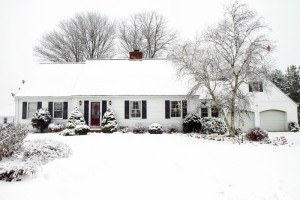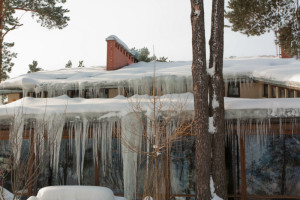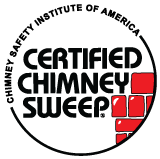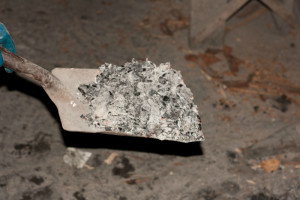by Billy Sweet | Dec 13, 2015 | Winter Storm Fireplace
In Boston, we are used to heavy snowstorms and blizzards during the winter. In January and February of 2015, we experienced a blizzard that lasted over six weeks and dumped a record 108.6 inches of snow in our area. Even though long-time residents know how to be ready for these types of storms, Billy Sweet Chimney Sweep would like to remind you of how you can prepare your fireplace so that you will not have to worry about being without heat when the power goes out during a blizzard.

Schedule a professional chimney sweeping and inspection before winter arrives.
This maintenance task will take care of removing all of the accumulated creosote from the inner walls of your chimney, which increases fireplace safety and reduces fire hazards. During the inspection, our Chimney Safety Institute of America (CSIA)-certified chimney sweeps will examine the condition of your fireplace and chimney to be sure everything is working safely. If we find any damage, we will make recommendations of the repairs that are necessary for you to use your fireplace safely.
Check the gaskets to see if they need to be repaired or replaced.
You want to ensure that the gaskets on your fireplace doors, damper, and ash dump are providing an effective seal. According to Cabin Living, without a proper seal, too much air can leak into the firebox and cause overfire and permanent damage to your fireplace.
Have the blower cleaned.
If your fireplace is equipped with a blower, you should clean off the dust and dirt from it to protect the balance of the blower. When the blower has too much dust accumulation on its blades, the balance can change and cause the bearings to wear out prematurely. Your fireplace blower typically will not have a filter to keep dust off, so you need to check it regularly to be sure it is clean.
Replace broken or deteriorated bricks in the lining.
When the brick lining is so damaged that it has deteriorated so much that the steel body of the firebox is exposed, the high temperatures can lead to permanent damage. Be sure the bricks are in good shape so you will not have to worry about damage occurring that could make your fireplace unsafe.
Billy Sweet Chimney Sweep is here to help you prepare your fireplace for dangerous storms this winter. Contact us to schedule an appointment for a chimney sweeping and inspection so that you can stay warm and safe this winter.
by Billy Sweet | Nov 28, 2015 | Freeze Thaw Cycle
You’re likely familiar with the damage the freeze-thaw cycle can do to the roadways; it’s what causes pot holes to appear each year! Water makes its way into the tiny cracks in concrete, asphalt, or stone. When the temperature drops, that water freezes and expands, causing the concrete, asphalt, or stone to crack or crumble. If you have a home with a masonry chimney, you should be aware that the freeze-thaw cycle can cause the same damage to your chimney’s bricks, concrete, and mortar.

Water damage and your chimney
Water can cause many problems with your chimney. The freeze-thaw cycle can cause the mortar between your chimney to crumble; it can cause parts of your brick to flake off, which is referred to as spalling; and it can cause your chimney crown to crack and crumble. Over time, if water damage goes unaddressed, it can mean major problems for your chimney. Your chimney’s overall structure can fail, causing it to lean and become unsafe. A damaged chimney also will let water into the rest of your home, leading to water stains on your ceiling and walls, rotting wood on adjacent structures, collapsed hearth support, a damaged firebox, rusted fireplace accessories, and failing hearth structure.
Repairing water damage
The first step in repairing water damage is to find that damage. This is one reason your annual chimney inspection is so important. Your certified chimney technician can find signs of damage early, so that it can be repaired before minor water damage becomes major water damage. In many cases, it will take the work of expert masons, like those at Billy Sweet Chimney Sweep to repair your chimney’s water damage. We provide services such as tuckpointing, chimney crown repair and replacement, and removing and replacing spalling bricks.
Preventing water damage
When it comes to water damage and your chimney, an ounce of prevention is worth a pound of cure! Taking steps to prevent chimney damage now can save you from costly repairs later. Having a chimney cap installed atop your flue can help keep water from running down the interior walls of your chimney. Repairing a damaged chimney crown will keep water from running down the exterior sides of your chimney. It’s important to make sure the flashing around your chimney is secure, and if your chimney is located on a part of your roof that experiences a lot of rainwater or snow, a cricket — a tent-shaped piece of metal — can be installed to divert water away from the chimney. There also are waterproofing sealants that can be applied to your chimney. Those sealants keep water from seeping into your chimney’s masonry while still allowing your chimney to expel the gases created by your fires.
Ultimately, the key to protecting your chimney from water damage is working with your certified chimney sweep to make sure that any problems are caught and addressed early before you have major chimney damage. If you’re overdue for an inspection, or if you’ve noticed cracking masonry on your chimney, call the experts at Billy Sweet today. We also can talk to you about waterproofing applications to protect your chimney.
by Billy Sweet | Nov 12, 2015 | CSIA Certification
When faced with deciding who is actually right and qualified for a job, it is important to look at the certifications of the company and their employees before settling. That mindset applies to doctors and dentists, and it certainly applies to chimney sweeps. In our field, receiving a CSIA (Chimney Safety Institute of America) certification not only gives us the best training in properly cleaning your chimney, it also educates on the best responses to worst-case scenarios like carbon monoxide and chimney fires. Knowing that your chimney sweep has the best qualifications will make Billy Sweet Chimney Sweep the easiest choice for you!

What we do as a profession was largely unregulated until 1983, when the CSIA was founded. This not for profit organization aims to educate not only those in our field, but also the public on how to maintain and correct any hazards their chimney or venting system may present over time. To become certified, there are two exams based on a comprehensive review time that can happen in person or online. Once those exams are completed thoroughly, a code of ethics is signed to ensure that sweeps can be trusted with the public’s safety. That also is tested through educational classes that discuss upcoming technologies and hard to grasp concepts, like physics through a certified sweep’s entire career.
The CSIA has several goals for their chimney sweeps including the need to fully eliminate any chimney related hazards that could threaten property, pets, and especially human lives. These hazards could come from carbon monoxide or chimney fires from creosote buildup. As certified chimney sweeps, we have several areas of knowledge that are all connected to the main purpose of prevention and education. Besides the basic practice of what we do, cleaning and inspecting chimneys and venting systems, we also involve ourselves with all the minutiae. Knowing all the factors and physics in the development of creosote, as well as the requirements from the EPA (Environmental Protection Agency) easily separate CSIA certified professionals from the companies that simply have the physical tools for the job. Our continuous education on a comprehensive list of subjects gives us confidence in our practice as well as in our sharing of that knowledge with our customers. We want our clientele to know what to expect from their chimney sweep, and we embrace the challenge to aim higher and know more!
We want anyone looking for a chimney sweep to look first at those that are CSIA certified. Not only are they more educated on what’s important, but they also care more about the home and people that are associated with the chimney. Thank you so much for choosing Billy Sweet Chimney Sweep as your CSIA certified sweeps for over 30 years!
by Billy Sweet | Oct 12, 2015 | Winter Fireplace
There is nothing quite like the first cold snap to send us all unpacking our winter clothes and grabbing the blankets out of the attic. Preparing yourself mentally is the first step, taking the proper precautions to prepare your fireplace for the upcoming season is another. Getting it ready now will save you the hassle and pain of dealing with it when there are several feet of snow outside!

The first step is the biggest:
Getting your fireplace professionally inspected and swept by our CSIA-certified sweeps will not only make sure that your fireplace is in the best shape possible to combat the degrading snow and water, as well as the smoke buildup that comes with use. The buildup, called creosote, is highly flammable, and could result in a chimney fire if you’re not careful. We not only clean the creosote off the inside of your chimney, we check for any loose or missing mortar so that your chimney is in tip-top shape before it takes on the winter.
Spic and span:
We want to inspect and sweep your chimney fireplace annually, but it is imperative that you do your part in keeping your fireplace clean as well. Disposing of the majority of ash and burnt timber in a wood-burning firebox will not only look more aesthetically pleasing and leave you more space for logs, but the chances of a flying ember catching your carpet on fire becomes a lot more slim. Just gently shovel the cooled ash into a bucket and dispose of it in the trash.
Putting a damper on it:
Your damper controls airflow in and out of your chimney. Check your damper for ease of use, making sure it opens and closes with no struggle. If the damper doesn’t close properly, there will be a cold draft that comes into the room when the fireplace isn’t in use. If the damper is hard to open, proper ventilation could keep carbon monoxide from exiting out the chimney, instead filling your room with the deadly chemical.
Fires of all kinds:
Weather you have a wood-burning fireplace or a gas stove, it is important to have enough fuel to keep you and your family warm for at least three days. Keep it in an easily accessible in case of a power outage. Also, make sure you have a supply of firefighting materials such as a fire extinguisher, a bucket of water, or baking soda readily available in case a fire gets out of hand or some buildup catches fire. Again, it’s always better to be over prepared.
Knowing that your fireplace and chimney are taken care of will give you peace of mind while the wind whistles through the trees outside. It’s not too late to schedule your annual inspection and sweeping. Call Billy Sweet Chimney Sweep today!
by Billy Sweet | Sep 26, 2015 | Proper Ash Disposal
Everyone knows ash to be the most obvious build up that a fire produces, the result of burning wood. But at what point does the ash need to be disposed of? Probably more often than a person would think. Protect yourself and help your plants with these instructions for the correct way to dispose of ash.
According to the Chimney Safety Institute of America (CSIA) it is actually a good thing to keep about an inch of ash beneath the grate of your fireplace to insulate hot coals and produce more heat during the winter season. While it does protect the bottom of the firebox and help the coals produce extra heat, too much of it can not only take precious space away from warmth-producing coals, it can be downright dangerous. Even ash that appears to be fully cool can fall onto nearby carpet or rugs and potentially start a fire.

The best way to dispose of excess ash is to wait at least a day after a fire was lit in the firebox before handing it. If that isn’t possible, wearing protective gloves when handling the bucket and shovel will minimize your risk of being burned. Gently scoop the ash from the firebox and place it in the bucket, leaving any hot coals and a thin layer of ash remaining. This will make your next fire easier to start. Carefully place the bucket in an area clear of any flammable material and away from kids or animals that may be tempted to play in the soft-looking pile. If possible, place a lid on top of the bucket to starve the hot ashes of oxygen, making them cool quicker. Sand will provide a similar reaction, but a lid is more easily accessible for most.
After three days, dispose of the ash in a paper or plastic garden bag. Sprinkling ash in your garden can be beneficial in small quantities, but don’t go crazy. Ash is very alkaline, so too much will change the pH of the soil, and kills your plants.
Besides just trashing your leftover ashes, there are several other alternatives to make use of them. Use your cool ashes to gently exfoliate the glass doors of your fireplace and remove that unattractive residue. If your pet gets into something smelly, rubbing ash on their coat will neutralize any gross odor. In the winter, pouring ash on your driveway and sidewalks melts ice and isn’t as harmful to the soil and concrete as salt is.
We want to ensure that everyone is safe and cozy this fall, and removing the ash from your firebox regularly is a key factor in ensuring that. When we come to sweep and inspect your chimney we will check the firebox to make sure it is in top working order. Give us a call to schedule!





